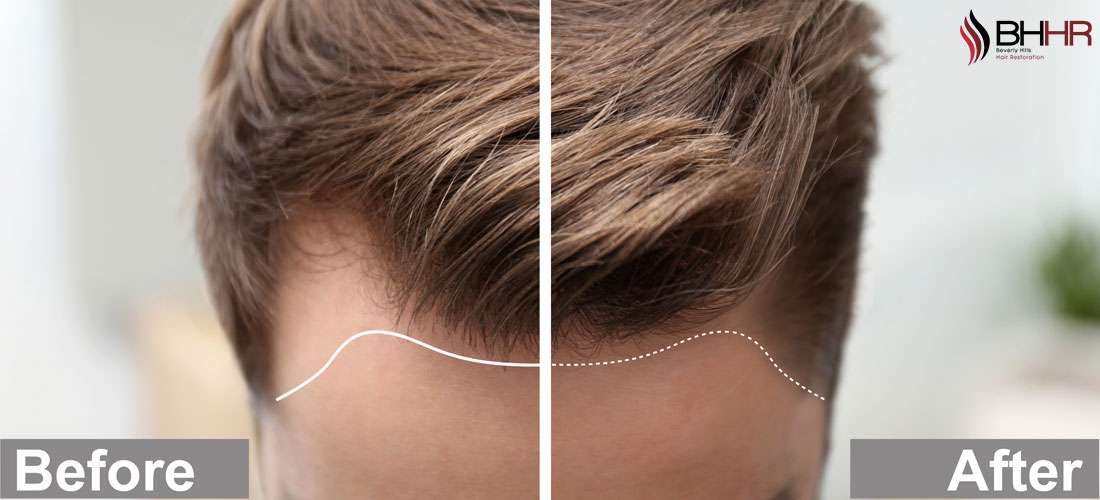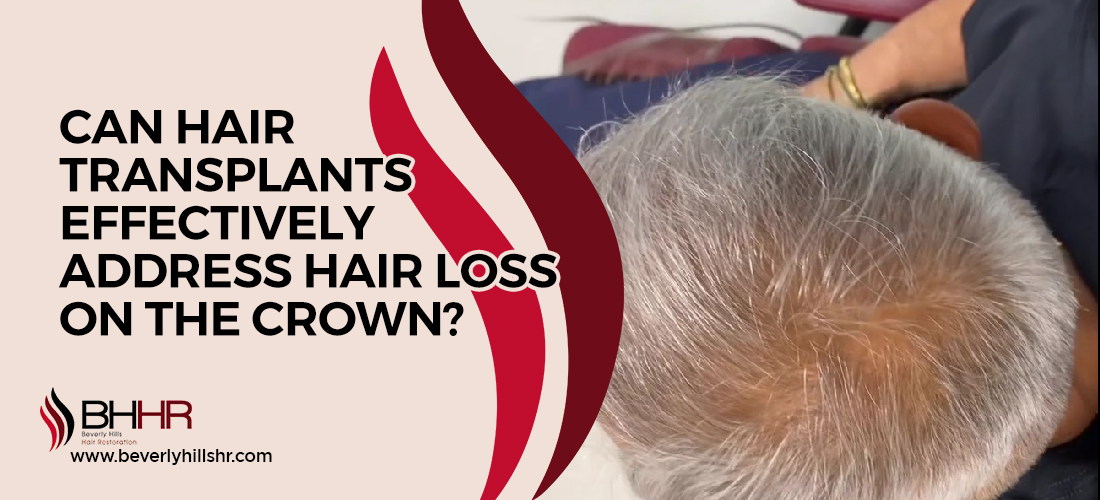Get The Natural Hairline back with Hair transplant
Home / Hair Transplant / Get The Natural Hairline back with Hair transplant
Updated On : April 23, 2024 | Category : Hair Transplant | Author: Beverly Hills Hair Restoration Team

Most of us have no hair in our heads when we are born. The tiny hair seen during birth is usually fine and may fall out as we grow to make healthy hair growth. Others are born with full hair on their heads, which also many feel about it as we see in many family photographs.
Hair will eventually grow as you grow up if there is none in the scalp. However, it may be hard to establish the texture, color, or shape of the hairline when we are young. The hairline starts to take shape when you begin to mature. Even though the overall hairstyle may stand up on end, wild, or curly, the hairline design will always be uniform all around the scalp. Hair is always positioned in the right place, just like the toes and fingers. For example, it is rare to find hair starting to grow from the eyebrows; it usually starts growing slightly above the eyebrows. It doesn't extend down the neck to our backs.
We all become conscious of our hair as we grow older. Children hardly notice their hair and are not even concerned about how it looks. To most of them, it gets in their way when they are coloring their books or riding their bikes. When we reach the adolescent stage, we start thinking of how our hair makes us look. The way we choose to style, wear, or color our hair helps to define who we are. The world will judge us on how our hair looks as much as you want to believe that you are not your hair!
Don't tell me that you have never envied your friend's or a celebrity's hair, wishing that it was yours! Most of us are never satisfied with how our hair looks. While some hope that their hair was thicker, longer, or darker, others wish it was a curler, straighter, or of a different color. We hardly think of our hairlines until we start losing hair.
In normal male pattern baldness, the hair will start to move up and backward towards the crown. This look is often called a receding hairline. In female pattern baldness, hair will stop growing around the crown and sometimes on top of the scalp. This type of thinking doesn't usually affect the hairline design. Most people find receding hairlines repulsive and often wish that they can do something to get rid of them. A hair transplant procedure is what many run to as a quick fix to the problem; that's why many research online for the best hair transplant clinic.
As you think of having a whole new hairline design and not just thicker hair, another thought also crosses your mind – will my hairline look better than before, or will it get worse? Will the procedure hurt? How much will it cost? Will the results look natural, or will everyone notice that you have just had a hairline hair transplant surgery? These are some of the questions that will linger in your mind when looking for a reputable hairline lowering surgeon—the type of surgeon that takes his profession very seriously.
This guide will explain how important it is to look for someone skilled enough to create a perfectly natural hairline design that is crafted or customized to suit your needs. You need to understand that your hair is as unique as yours, and therefore you can't replace your hairline with someone else's. Read on if you plan to have a hairline lowering surgery to find out what you should expect.
Designing the Perfect, Individual, Hairline
We will start by defining what a hairline is for you to understand better what we are talking about. The space on the scalp where the hair meets the forehead is what is known as the hairline. In normal cases, a hairline will be a few centimeters above the eyebrows. It is the most noticeable on your face, and it is the first facial feature that you will see when you look into the mirror. When you have a conversation with anyone, you will notice their eyes are fixed on it. The hairline design contributes so much to your facial beauty. Your hairdresser is the only one who will look at you from behind and fail to notice your forehead.
A hair restoration surgeon does more than just restore lost hair. When it comes to hairline lowering surgery, an expert surgeon will design a natural-looking hairline that is hardly noticeable. This is because such a procedure plays a huge role in transforming a person's life. Besides having the right skills and expertise to perform this procedure, having an artistic eye is also important.
The natural line of the hairline
Most of the people who undergo hairline transplants procedures like to keep it low. But you can also make it obvious if you want. Wherever you desire as a patient, you want to keep it as natural as possible. Natural, in this case, means having the hairline design look uneven around the scalp. When the results become unnatural, the hairline will have a straight line-shaped like an arc around your forehead. Only dolls will have such hairlines. As a person, you will always bump somewhere along the hairline that defines your uniqueness.
Starting with thinner hairs
Hair will always start less dense on the hairline, and only the top and the back of the head will have thicker hair. A good surgeon will always start by transplanting thinner hair where the hairline starts. At Beverly Hills Hair Restoration, doctors only use the FUE – follicular unit extraction – hair transplant procedure when treating a naturally high hairline. We do this because this hair transplant procedure is regarded as the standard gold technique, which is far better than the follicular unit transplantation that is more invasive.
The FUE procedure involves the surgeon using a special punch device that harvests units of tissue containing up to three or four hair follicles. The unit also has 20 strands of hair. The hair is removed from the donor area of the scalp, which normally has thicker hair. After that, the extracted hair will be implanted in the recipient area of the scalp. This is the area that has refused to grow hair. It is up to the surgeon to decide where and how the transplanted hair will grow. When treating a receding hairline, the doctor will start by implanting finer hair where the hairline begins. Thicker donor hair will have to go further back of the hairline. Replicating the natural hairline design means that the new hairline will perform its purpose – it will connect the beginning of the hair with the end of the forehead. It will do this and not look too obvious. A technique that entails adding follicles in a 'micro-irregular' pattern is used in the 'feathering zone.' In the hairline lowering procedure, the immediate hairline is implanted using hair follicles with a single hair strand. The rows behind will receive hair follicles with two strands, and they will continue getting thicker, moving further back.
The way the hair naturally grows
Another factor that needs to be taken into consideration is the direction where the hair grows. A good surgeon will ensure that the transplanted hair grows in the right direction. The doctor focuses on designing the hairline in the right angle, depth, angle, and frequency, which helps achieve a seamless look.
Your natural features and age
The patient's age is another factor for considering when transplanting hair in the receding areas of the hairline. The natural features of the face here include the shape of the face and the forehead protraction. The doctor will also ask you how you used to be before the hair loss. It's quite natural for a man's hairline design to move back a bit. This will also have to be put into account by the doctor. It will be quite weird for a forty-year-old man to have the hairline of a twenty-year-old man. While performing the procedure, hair transplant surgeon will consider achieving a more natural look.
Your current hair
Another thing that the surgeon needs to consider is the amount of donor's hair that is available. This will also influence what your future hair loss is likely to be. A good surgeon will avoid using too much donor hair to treat receding hairlines. The harvested hair has to be just enough to fill the areas in the scalp that had refused to grow. If there is a possibility of future hair loss, there has to be enough hair left in the donor area to cover such a situation, and a good surgeon will do that math.
If you are suffering from male pattern baldness, it is more likely to continue unless you intend to take hair loss medication for the rest of your life or you are just filling the front of the scalp because you want thicker hair and you are not losing hair. If it is male pattern baldness, where it seems to stop now is not where you will find it in a couple of years. This means that subsequent hair transplant procedures will be inevitable. Although this doesn't happen to everyone, it is good to rule it out by seeking consultation from your doctor.
If your doctor sees a possibility of you suffering from advanced hair loss in the future, he will preserve the donor hair in case you are going to need it in another hair transplant procedure in the future. While some doctors will advise you to take medications such as Propecia to prevent your hair loss from getting worse, others suggest waiting until your hair loss has stabilized before undergoing another hair transplant procedure.
Using the Face Shape as a Guide
To create the perfect hairline design, most skilled surgeons will use a technique that originated from Michelangelo. He learned this skill when painting a human face. The doctor will divide the face equally into three parts. These parts include the exact middle part of the hairline, the midline, a few centimeters from the glabella, and the part found between the eyebrows above the forehead. The doctor will then have to create a curve that will sweep from midline around each side of the head. This line will run straight up the temple area.
A measurement from the outer corner of each eye will be used to determine the hairline on each side. You may not understand everything we are trying to explain, but to simply put it, a qualified surgeon will ensure that results will come out as naturally as possible. Based on a study in the Surgical and Radiologic Anatomy journal in June 2017, this technique is used by aestheticians to design natural-looking hairlines.
The study took place in Turkey at a university called Ege University in Izmir. After looking at the shapes of faces of 200 young adults, they came up with five hairline shapes contours. They included M-shaped, round, bell-shaped, rectangular, and triangular. While female hairline shapes tend to be rounder, male hairlines are often M-shaped or rectangular. The foreheads of each person were measured in height and width. In many procedures now that concern receding hairlines, the information that was produced from the study is used to determine a natural hairline design before the procedure begins.
Conclusion
In this article, we have discussed several different factors that surgeons use when designing natural hairlines. Many patients often look for a more natural look when treating receding hairlines, and this means that they have to look for the best-skilled doctors who have years of experience to perform such procedures. Professional aesthetic surgeons employ perfect surgical skills and artistic skills to achieve the best natural hair transplant procedures that are second to none. If you want to get the best results from a hair transplant procedure, seek services from Beverly Hills Hair Restoration in Los Angeles, California.
Here are a few more topics that you shouldn’t miss:
Everything You Need To Know About Beard Transplant?
Like this post? Don’t forget to share



